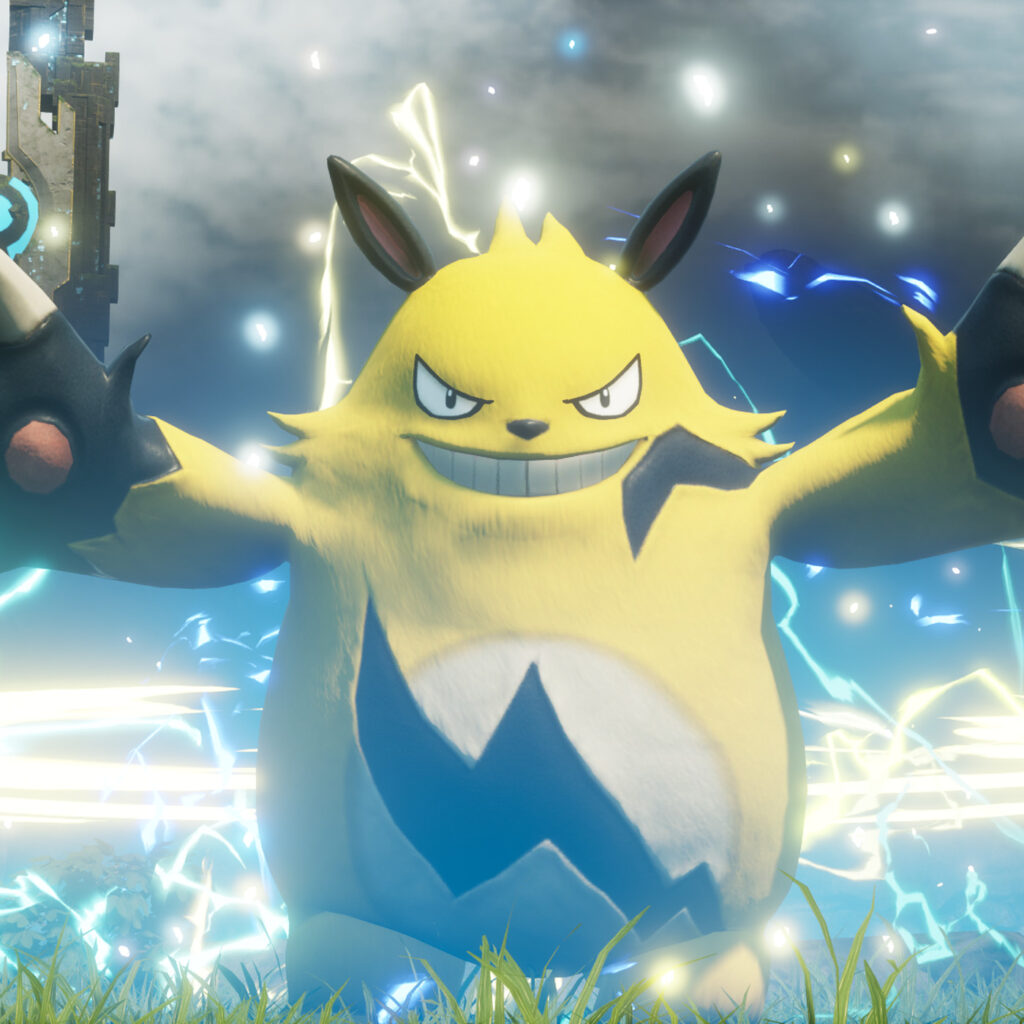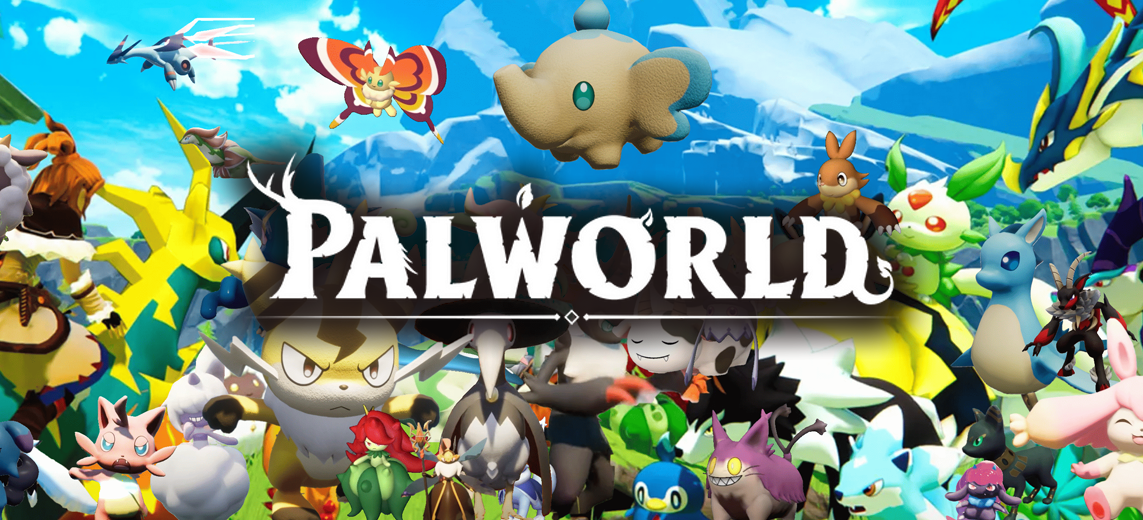Palworld a new early access companion-based building, crafting and exploration game that has taken the industry by storm. With more than 7 million copies sold its first week, there’s a reason this title is so incredibly popular. While people can say it’s “like” Pokémon, it’s not Pokémon. It’s something new, different, and even better for modern times.
Part of the success of Palworld is due to the broad audience it was designed for. Kids, adults, professionals, students… you name it. Everyone can enjoy this game which is often delightful, challenging, and sometimes outright silly. But in a good way.
- Developed By: Pocketpair, Inc.
- Release Date: January 19, 2024
- Version Reviewed: 1.0.2.113940
First, a little background on Pocketpair. They created two games prior to Palworld. The first was OverDungeon, a real-time card battle game in August of 2019. After that, they created a game called Craftopia released in September 2020. Palworld is their third real game, and to say they struck gold is an understatement.
Palworld is something special. Let’s dig into why…
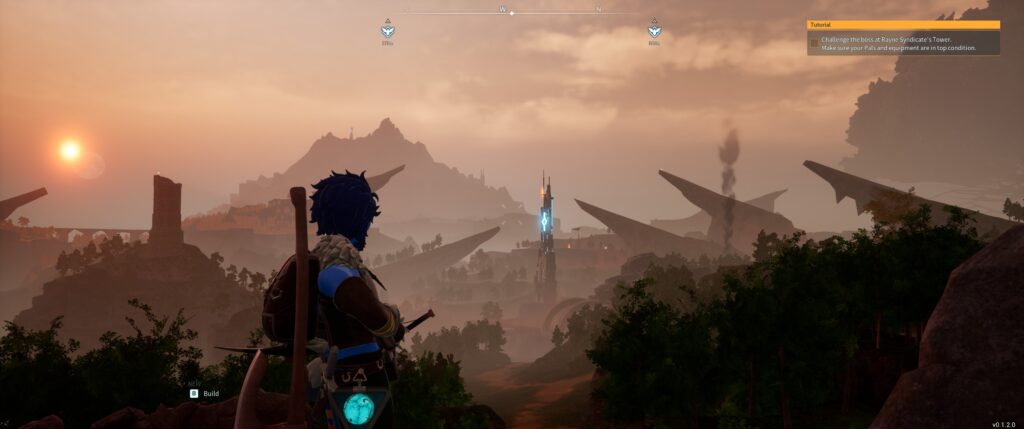
Table of Contents
Content
The first thing a player does is to create their own custom world. This includes the name, multiplayer setting and difficulty. The Difficulty Settings are fantastic, and probably the best overall set of configurable options I’ve seen for a large world-based exploration game. I wish Valheim would have launched with such a great set of configuration options. Players can change nearly every core setting available. One can make combat easier, or populate the world with more Pals. Change regeneration, damage, day/night cycles. It’s all in here, which allows for custom experiences, especially for those who want to play hardcore or with no death penalty at all.
Want to increase the number of Pals that spawn in your world, or remove the death penalty? An existing world’s settings can be changed at any time from the main menu.
After creating the core world, the player Creates the Character they will use within that world. This includes customization of body, face, hair and voice. While it’s fairly basic, it has fun sliders so people can make wonky looking characters, and I’m sure it’s only a matter of time before mods come out that allow some truly fun character designs.
The World is static and huge. There’s so much to explore and see that one would think a static realm would quickly become boring. It doesn’t. Key items spawn in different areas, and the variance in Pal spawns based upon region with day and night cycle makes each game different, along with the ability to change the settings. By creating a static world the developers have refined it perfectly to be balanced and replayable. There’s towns, waypoints, enemy strongholds and tons of places where the player can build bases. The game also has day/night cycles which make a big difference because certain Pals come out only during the day or night, and key items the player needs to find are much more visible during the night time. When the sun goes down, most players fly around the map picking up key items that become very visible due to their glow.
Parts of the world also have climates that must be endured. The desert is hot and the mountains are cold, so custom armor and/or underclothing is required to survive the temperatures in those regions.
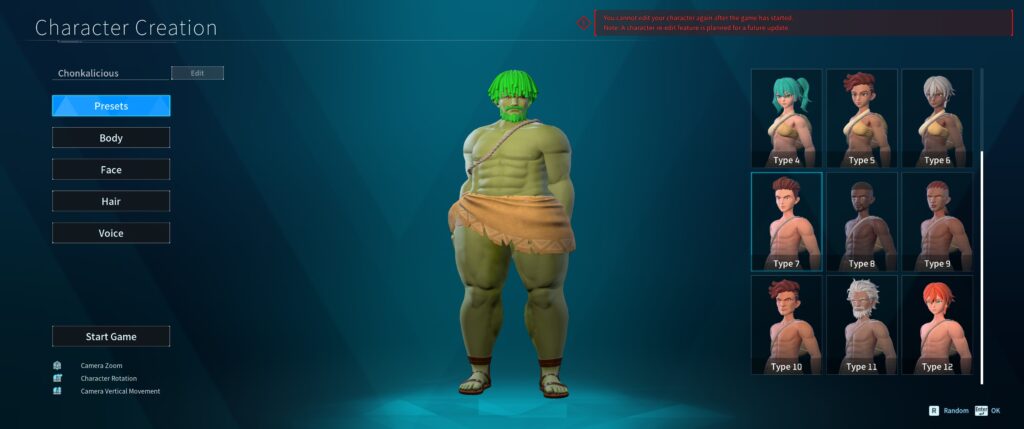
There are also dungeons, static boss spawns, transportation pylons and boss towers spread throughout the world. The Dungeons are fun because they contain specific Pals, resources, and can spawn boss-level versions of Pals the player is hunting for. World bosses are located on the world map and defined with their name and level. Towers are indoor single room boss fights, and there are currently five boss towers in the world.
The world is littered with resources. This includes materials, spheres, eggs, effigies, and chests. Some locations are static, but what they provide can be different each time. Red chests require a key to unlock, and eggs come in normal, large and huge sizes. Huge eggs have the possibility of hatching into some of the most powerful Pals in the game, and once a player gains the ability to fly and survive the cold and hot climates, they can fly into areas that are much higher level and get eggs that can produce Pals far beyond their current level.
The game has a World Map that allows Markers to be placed. It also shows bosses, towers, waypoints, and the areas you’ve explored. I wish it showed dungeon entrances, but players can use the marker system to tag them.
There’s a mod available that adds a minimap to the game, which can be quite helpful for those who are accustomed to having one!
The entire game revolves around Pals. The creatures that inhabit the world, and the often silly and fun little (sometimes big) critters the player must fight and capture to build a base and grow. They range from cute and cuddly to dangerous and… still often cute. The design of the game world is a fun mish mash of anime and silliness all brought together with a very complex and well designed infrastructure that gives both the casual player and hardcore player not only something to always do, but to just have fun. All of that is hard to do, but Palworld pulls it off. And that’s why so many people are playing this game and having a blast. Capturing Pals is the main feature of the game, and doing so requires spheres. Players often need to use weapons to “whittle down” their targets for easier capture while also having armor and other standard equipment to survive. Once a Pal is captured, the player can use it in adventure or put it to work at a base. While the player can only have one Pal out at a time for fighting and support, there’s craftable gear that allows multiple Pals to be out at once. Players can name their Pals, teach them skills, breed them to make them stronger, enhance them to improve their stats, and assign them tasks based on their Work Suitability. There are 12 Pal work-related categories in the game: Kindling, Planting, Handiwork, Lumbering, Medicine Production, Transportation, Watering, Generating Electricity, Gathering, Mining, Cooling and Farming. Some Pals are good at multiple things and will run around the base doing random tasks while others are good at just one or two things and focus on those. There are some issues with Pal AI with the current release, but I’m confident the developers will get them addressed very soon. I cover the mechanics behind Pals in more detail below.
Each Pal has something called a Partner Skill. This is a custom skill that’s available when the Pal is active. And boy, some of the partner skills are a blast. Literally. Some partner skills include flying or riding while others are to perch on your shoulder and shoot a submachine gun, or follow you around and pick up items (which doesn’t count toward being an active Pal) while looking cute and cuddly.
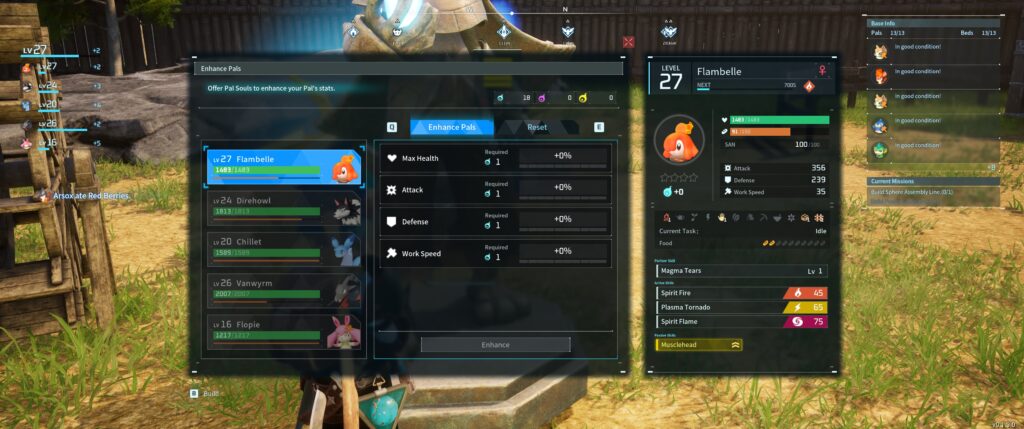
Passive Skills are critical in this game, and there are 58 of them in total. Each Pal you capture has a random chance of having different passive skills. They come in different tiers and can affect everything from combat viability to work speed. Some are positive and others negative. The more sought after passives combine multiple values, such as Attack, Defense and Movement Speed. Want a Pal that is more productive? Find, hatch or breed one with Artisan. Have a Pal with Slacker? They’ll work 30% slower. Looking for the fastest mount? Swift is the best. This is one of the most fun parts of the game because players are constantly looking for specific passives on specific Pals, and once they are found, that Pal can be bred with another to create super Pals with all legendary skills. For example, one of the most powerful Pals would have Legend, Lucky and Musclehead. The chance of finding that combination in the wild is very slim, but that’s what breeding is for (and covered below under Mechanics).
In addition to having a level, Pals also have a rank, which is represented by the stars on their stat page. A player can use a Condenser to take many other Pals and upgrade a single one, which will raise that Pal’s Work Suitability and Stats. All Pals start at 0 stars and can be upgraded to 4. I cover this in more detail below in detail under Mechanics.
The game also has the ultra rare Pal Shinies, which are larger higher stat value versions of Pals. It’s cool to catch them because they are larger than the others and the enhanced stats really make a difference. But they are ultra rare. For those who play with sound, there’s a unique “shimmery” sound one can hear in the distance when one is near. Follow the sound!
The player can store a total of 480 Pals in their Palbox. Getting full? Condense (covered below) or sell them to a merchant for gold!
The player can have up to five Pals in their party at any given time, but as mentioned above, generally only one will be active. The nice part of this system is the player can recall and call any Pal in their party at any given time. This is very useful for combat situations, especially against bosses, as players can cycle through their Pals. As such, a player can have a Flying Pal, a Riding Pal, a Combat Pal, and support Pals that do everything from defense to picking up items around the player.
The Paldeck is a system within the game that fills out as you discover Pals. It contains the details of the Pal, their Partner Skill, Work Suitability, Item Drops, and Spawn Locations (for day/night). It also tells the player if they’ve achieved the Capture Bonus, which is a big deal because bonus XP is given for the first 10 captures of any Pal.
The game features a wide variety of equipment the player can put on and use as they adventure throughout the world. This includes pickaxes for mining minerals, axes for chopping wood, crossbows and guns, and even swords. There’s also head and body armor, a shield, glider, and two accessories (necklaces, temperature undershirts, etc.). The starting weapons are pretty basic, but later on players get access to firearms, which are a lot of fun to use. And we can’t forget the rocket launcher. Players can also craft a grappling hook, which can be very useful when transporting very heavy goods from one location to another in a base. There’s also a glider, which allows the player to jump off of high peaks and glide for long distances.
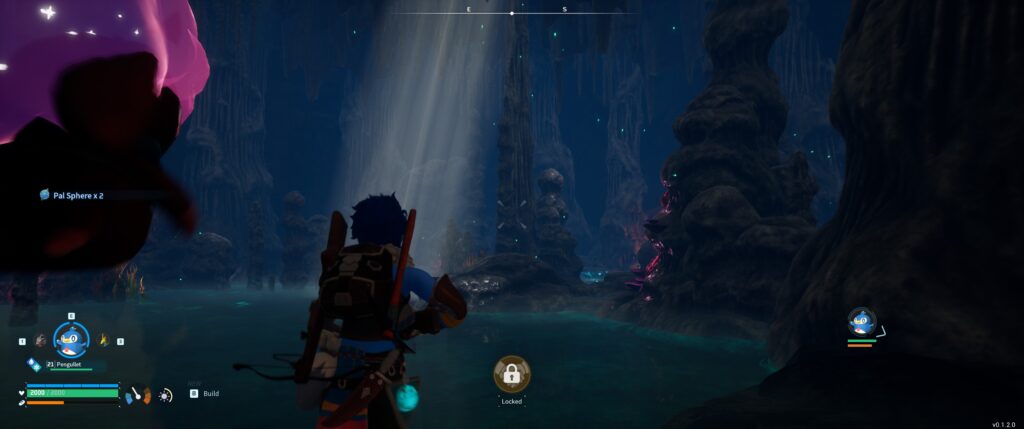
Base building is the other key component of the game. Not just building a base, but putting Pals to work in the base. This is where the complexity of the game starts to really shine. Certain pals are better at one thing than another, and some can only do specific tasks. Before long, the player will have a dozen Pals in their base all running around doing everything from watering plants to blowing fire into a furnace in order to make ingots so the player can craft that shiny new weapon. The building system is locked behind the Character Level and Technology system. Ancient Technology Points are awarded by defeating world bosses for the first time, and Technology Points are awarded by leveling and discovering waypoints. It’s important to build a base on flat land because it makes placing structures a lot easier.
If you cut trees down and build foundations over them, the trees won’t grow back.
Next we have Resource Gathering. Once a base is built, resources are required to make items, feed your Pals and construct additional base enhancements. Wood, Stone, Paldium and Ore are the core materials needed to build the starting structures and equipment. Base building comes in 10 categories: Production, Pal, Storage, Food, Infrastructure, Lighting, Foundations, Defenses, Other and Furniture. There’s a lot to build, and it’s all unlocked by leveling up, discovering waypoints and defeating bosses.
One fantastic feature is all storage containers in the base are accessible and used in building, both by you and your Pals. Such a simple quality of life option makes a big difference. The player can also press R to deposit all matching items from their inventory to the selected container.
Technology is at the center of the game, unlocking the ability to craft equipment, base building objects, and even special Pal devices such as saddles and collars. This also includes Pal Spheres, which come in 5 different tiers. I really like the system because it shows you what to look forward to and progresses properly, starting at with archaic weapons and buildings then evolving into much more sophisticated weaponry and even electrical systems. Rocket Launchers, Assembly Lines, Assault Rifles, Lamps… all of this fun stuff is available for you to unlock and build as your character grows in level.
Palworld has a solid fast travel system via your base and Waypoints. Additionally, the discovery of waypoints provides technology points which allows the player to unlock Technology. I really like how quick the game load when traveling between points.
One interesting note is building a base with materials such as wood can be problematic later on as fire-based raids can take place, which can result in an entire base catching fire and burning down!
The game world features both Towns and Merchants. I cover the merchants in more detail below under Economy. Towns are pretty much just aesthetic places to interact with NPCs, grab a waypoint, and purchase or sell items from and to a merchant.
There are also Syndicate Bases that hold Pals in cages that the player can rescue. In addition to Pals, members of the Syndicate roam the world and are very hostile. The good news is they drop medicine, ammo, and other useful items, so it can be very rewarding to fight them. Especially if you have a Pal with great AoE fire attacks… burn, baby! Burn!
The game also features Item Schematics, which can be looted from chests and bosses and are covered in more detail below.
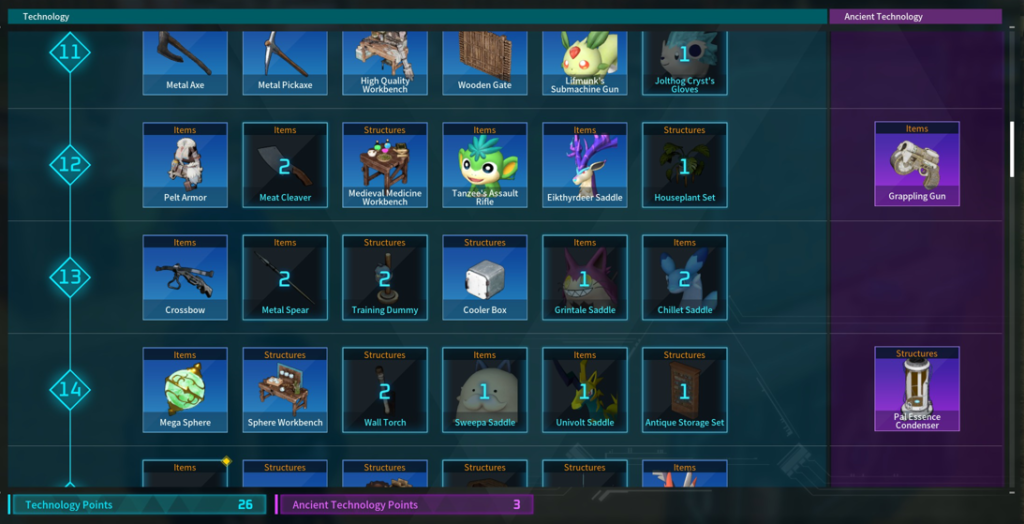
Gameplay & Mechanics
The core gameplay of Palworld revolves around Combat, but part of that combat is weakening targets and capturing them. A player will always get more experience capturing a Pal than killing it, but quite often when one is looking to farm specific crafting materials, they will hop on a mount and go out to a specific location and use their mount to attack and kill Pals to get their resources. Dodging is a very important part of fighting and most attacks from enemy Pals can be avoided by reacting just at the right moment. In the end, the combat is fun and in some ways simple, yet complex enough to be challenging when fighting tough targets. Inflicting certain ailments on a Pal, like Cold or Electrical shock can increase the capture chance. There’s also a Stun Baton, which helps with the capture process..
If a Pal becomes incapacitated, put it in your base and let a transport Pal carry it to a resting spot. The Pal can then be moved back into your inventory and they’re good as new!
The Pal command wheel can be used to issue commands to your party Pals, or a working Pal you have selected. From here, you can pet, feed, emote, and give commands to not attack, focus on same enemy or attack everything aggressively.
Each Pal has three Active Skills which are its attack types. Players can teach their Pals additional skills with Fruits, which are covered below. These Active Skills are the “big attacks” that Pals will execute, and some of them are both visually impressive and devastating to targets. Others are just fun to watch!
You can butcher your pals to get their drops. This includes captured bosses, which will drop ancient technology again!
It’s important to mention Ammunition plays a big part in the game and requires constant manufacturing at the base to keep up with the needs of combat, especially at mid and late-game. This includes arrows, bullets and Pal Spheres. At this time there are six Pal Spheres that can be crafted. I’m listing them along with the recommended level of the target they are optimal for: Base (1-9), Mega (10-19), Giga (20-29), Hyper (30-39), Ultra (40-49) and Legendary (50). While it’s possible to use a Mega sphere to capture a level 30 Pal, the chance is substantially lower than using a Hyper sphere. Legendary spheres are the best in the game. But they cost a lot of end-game materials to craft, so they are generally saved for end-game Pals and level 50 bosses.
If enabled (which defaults to On for normal difficulty), Raids can happen to your bases, and when they do, your work Pals will engage the invaders. Players can craft an Alarm Bell at their base, which when rang will prepare the Pals working at the base for combat. There’s also numerous defenses one can build such as sandbags and traps. One advantage to raids is the mobs will often drop a lot of loot, including keys which can open locked Red chests.
Pals use different Elements to attack, and depending on the element type of Pal, it could have a natural defense. Some Pals use more than one element. For example, Chillet has both Ice and Dragon. Using the below diagram, if a Fire Pal attacks a Water Pal, it will do far less damage, but if a Fire Pal attacks a Grass Pal, it will do extra damage. The below element reference chart is very useful when planning to take on tough Pals such as bosses.
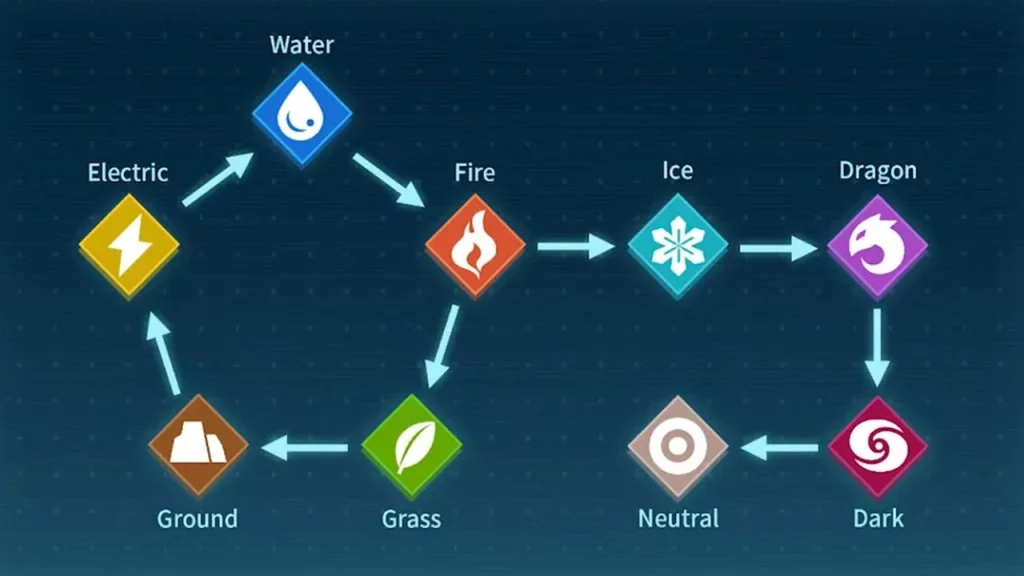
Food is a key mechanic of the game, both for the player and Pals. Everyone must be fed to stay at optimal health, and if the player or Pal runs out of food, they begin to starve. While a player or Pal won’t die from starvation, they can go to 1 hit point, and hits will not recover when starving. Players build Farms and assign Pals with planting, watering, and gathering work skills to automate the processes. Cooking allows for the creation of more complex meals that provide better nutrition value. Berries are the starting food, but around mid-game, the player needs to focus on making their Pals better things to eat.
The three foods that are easy to make and will keep your Pals happy are: Jam-filled buns, Salad, Cotton Candy and Bread.
The Food system influences Pal Sanity (SAN). A well-fed working Pal is generally happy. One that isn’t properly fed and able to rest loses its SAN value and work efficiency. Different foods have different Nutritional Values. The lower the value the more of the food the Pal will need to eat. At this time, there is no restriction on what foods a Pal can eat, only the bonuses from food (such as increased workspeed) and the SAN improvement. Players can place a Feed Box at their base to store food for their working Pals. The Pals will always eat the food in the first filled slot. The game also has Feed Bags that can be equipped by the player to automatically feed themselves and the Pals in their party. Here’s a useful spreadsheet that breaks down the foods in the game and their Nutrition value. Players can also build other base support objects to help regulate Pal Sanity (SAN) such as Hot Springs.
Starting around mid-game, your Pals can get hurt if they have a low SAN value. This is where Medicine comes into play. One of the main reasons a Pal will run out of SAN or get hurt is due to AI pathing issues (getting stuck) and not providing proper food and relaxation. A well designed base with everything spread out (to avoid AI collisions) along with tier 2 or higher food can often keep your working Pals in perfect condition, negating the need for medicine. You can also put a hurt working Pal back in your Palbox to have it regenerate and reset. In addition to crafting Medicine, you can purchase it from Merchants.
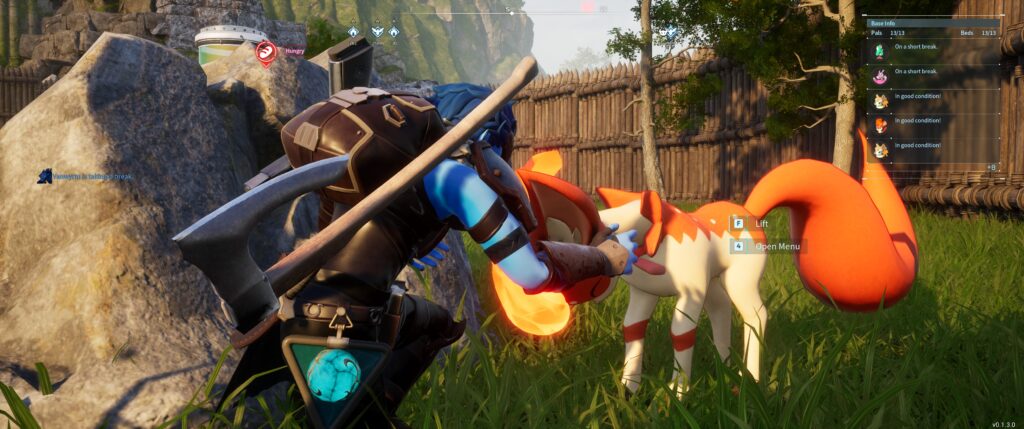
Next let’s cover Farming, which is another critical part of the game and a key mechanic. There’s currently 13 Pals in the game with the ability to Farm, and each of them provide different resources. Lamball provide wool. Beegardes provide Honey. Vixys dig up Pal Spheres and Arrows. Maus dig up gold. Want Cotton Candy, one of the best SAN restoration foods? Woolipops farm that. In general, whatever a Pal can far they will also drop when you capture or kill them as well. In the early stage of the game, a farm of Vixys is critical to digging up tons of Pal Spheres. Want leather? Assign Melpacas. A breakdown of the Pals and what they farm can be found here.
Dark pals will work through the night!
Movement consists of walking, running (with sprint), sliding, using a Glider, riding or flying on a mount, and using either location or base waypoints. Overall, all forms of movement are very smooth. Especially summoning your mount and jumping on its back. The key passive skills for a rideable mount are: Swift, Runner, Legend, and Nimble. it’s also important to mention the player can climb any cliff face in the game, the question is do they have enough stamina to reach the top?
The max Character Level and highest Pal level in the game is currently 50, but there’s already mods that increase this value.
Let’s talk about Stats. The player has Health, Stamina, Attack, Defense, Work Speed and Weight. Pals have Attack, Defense and Work Speed. Most of the player stats are pretty self explanatory. Stamina is used for sprinting and climbing, and Pal Stamina is used for sprinting and flying. The player can raise these stats with every level, but the amount that’s raised per point is different depending on the stats. In general, players focus on putting stat points in: Weight, Health and Stamina. Work Speed can help later on as well to speed up complex building, but with a really efficient base and enhanced Pals, they can do all the work for you. The player can also get a Shield, which is craftable. It recharges after not taking damage for a period of time and helps to act as a buffer before the loss of health. Armor will impact the total Defense value, and some Pals can increase things like weight.

Carry weight is a very important factor in the game, especially early on. Most of the smaller items don’t have much weight to them, but once the player wants to go out and mine ore and other materials in the world, weight fills up very quickly; much quicker than the inventory slots. Having certain Pals in your party can increase your carry weight in addition to putting stat points into it.
Want extra carry weight early on? Have Cattivas in your party! Later on, the Wumpo Botan is one of the best carry weight enhancers.
Building is a lot of fun in this game. While it is not as in-depth as pure survival games like Valheim, the player can focus solely on productivity and resource gathering while ignoring aesthetics, or go all out and build cool structures that just look good. In the end, layout is the most important thing and the majority of all building will be outside. I’m actually not aware of any items that must be built indoors that make a huge difference in the game other than a bed, which allows the player to sleep through the night. Both building and crafting have Workload values, which are just the amount of time it takes to craft something. All building requires materials ranging from wood to pal fluids. A complete list of materials in the game can be found here.
Placing storage containers near automated manufacturing is very important for efficiency and cuts down on transportation time.
Crafting takes place at workbenches and other stations that produce items and materials. The cool thing is all crafting can be automated and/or done by Pals. If the player wants, they never have to craft a single thing. They only have to initiate the craft and then assign their Pals to do it. Recipes are unlocked through the Technology tree, but there are also Schematics that can be found throughout the world that offer enhanced version of the base items all the way up to Legendary (gold) quality. For example, a Legendary Assault Rifle does a ton more damage than the base one, and the only way to get it is to find the schematic. At this time, equipment can’t be enhanced. A base item can’t be upgraded. The higher quality version must be built from scratch. Unfortunately, there is no salvage option so old items are usually discarded.
Players can manually pick up a Pal and assign them to work at a specific station by dropping the Pal on that station.
Next we have one of the most fun and important mechanics of the game: Pal Enhancement. There are multiple ways to make your Pal’s stronger. Condensing, Breeding, Statue Buffing and Skill Fruits. This is where players really get focused and the fun factor kicks in.
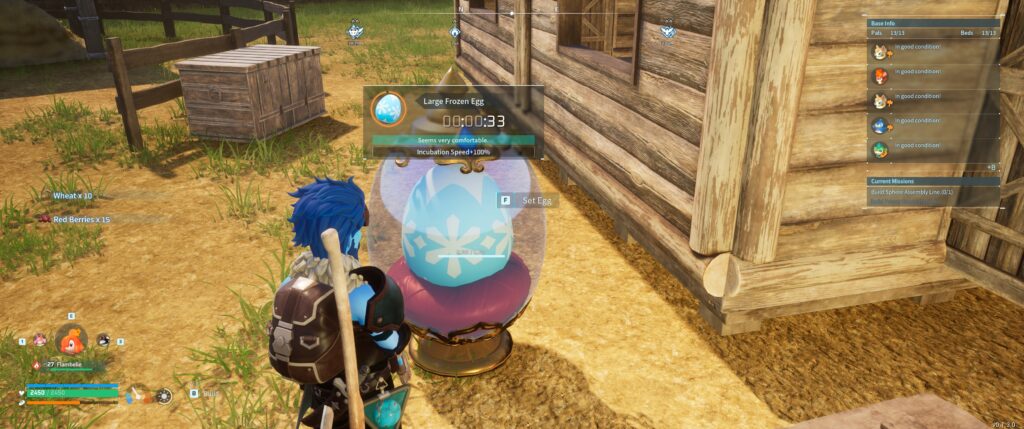
Condensing is a method that takes multiple Pals and merges them into a destination Pal to raise its quality. It takes a total of 116 Pals to raise one to the maximum rank. In other words, it takes a lot of time, and is nearly impossible with ultra high level Pals because they are so rare. But ranking up lower and even mid-level Pals just takes time and patience. To raise a Pal from rank 0 to rank 1 only takes 4. But rank 1 to 2 is 16. Rank 2 to 3 is 32 and rank 3 to 4 is 64. But oh boy, a rank 4 Pal with the right attributes is a total monster. You can only condense the same species of Pal. Raising the quality level also increases the Pal’s work skill levels, so a quality 2 Foxspark will have level 2 kindling. Using a Rank 4 Foxspark’s special flame attack is… beautiful.
Anubis is one of the best working Pals you can get for your base and can be bred with a Penking (level 15) and Bushi (level 23).
Breeding is the mid to end-game method players use to create Pals with specific Passive Skills. It’s very in-depth as to what a player can do, and I believe there are more than 18,000 breeding combinations. Breeding requires two compatible Pals, one male and one female, and Cake. Luckily, there’s a great website that lets you put in what Pal you’re trying to Breed and it tells you the compatible parents. Hats off to Anthony Kimpton for making the great tool. Buy the guy a coffee! Here’s the link. I’m also including a detailed video on how Breeding works below since it’s pretty in-depth. It’s also important to note the rank of a parent Pal (e.g. 2 star) will carry over to its offspring.
Statue Buffing uses Pal Fluids to enhance a Pal’s Health, Attack, Defense and Work Speed. A player can put up to 10 points in each attribute, but it can become quite costly after time. However, the result is well worth it. Having a rank 4 Pal with some of the best Passives and maxed Attack Speed can make it utterly devastating.
Want to farm Pal Fluids!? Go into the Penking boss dungeon and kill all the little Pengullets. Don’t kill the boss. Exit to the main menu, reload and repeat!
Skill Fruits are picked from the rare trees spread throughout the world and are capable of teaching a Pal any unique attack in the game. They come in all different element types and there’s a total of 52 currently in the game. Any skill can be trained on any Pal, which means the player could take a fire pal and teach it cold skills and then configure the Pal to use those skills. It also allows a player to adjust their primary fighting Pal to change the types of attacks based on the targets they’re fighting. Here’s a link of all Skill Fruit Tree locations in the world.
The Incubator is used to hatch eggs that are littered throughout the world, and one of the methods a player can use to get an end-game Pal they otherwise wouldn’t be able to tame. Some players have gotten lucky enough to get the end-game bosses from Eggs, all without even having to defeat them. For this reason, building multiple Incubators and hatching every egg you find is important. Many players build 10 or even 20 Incubators to constantly hatch eggs. Depending on the type of egg, placing a fire next to the incubator might cause it to hatch more quickly. But the heat and cold requirements only affect the time it takes to hatch, not if it will hatch. The other great part about hatching eggs is you get experience as if you captured them!
Lifmunk Effigies are little green statues spread throughout the world and can be turned in at the Statue of Power to increase Capture Power. There are a total of 10 levels, and each level affects the global capture rate. While I’m not sure what the exact number is, it’s estimated to be 1-2% per point, but with the different types of spheres it’s hard to tell what the real improvement percentage is. It is very easy to level up in the beginning. Similar to increasing the quality of a Pal through condensation, the Capture Power ranks up at the following values: 3, 7, 11, 15, 19, 23, 27, 31, 35 and finally 39, for a total of 210 to reach Level 10.
The Death penalty is based on the world configuration setting, which is: No Drops, Drop all items except equipment, drop all items (Default), drop all items and Pals in party.
Equipment often needs to be repaired, which is done at the repair station and costs materials. Damaged base structure can also be repaired, which can be important after a raid. If a workstation or structure is damaged, its efficiency will drop until it’s repaired. That and wooden structures can burn. Be careful of raids with fire!

Economy
This is probably the weakest part of the game. While there is a core gold-based economy, I don’t really see many players focusing on it. Merchants buy and sell numerous useful items, which can be helpful at beginning and mid-game. Players can also sell Pals and items for gold. The Black Market Merchant can also sell unique and hard to find Pals.
Many people use Merchants to obtain their Ammo because it’s very costly and time consuming to make mid-game. Players can also sell extra Pals to the merchant for gold (versus condensing them). One lucrative money making technique is to craft nails from Ingots and sell them for a high value to merchants.
Merchants can be captured and placed in your base to quickly access the ability to buy and sell, and they refresh their inventory if you remove and replace them in your base. They’re a great source of bones for cement, or if you’re lucky enough to capture a Black Market Merchant, you now have a new source for buying Pals you may not have already found.
Community
I’ll admit, I only played Palworld solo. However, I watched many streamers playing with friends and they all seem to be having a blast. There are a few bugs that are specific to multiplayer, but overall, it appears to be very fun to play with friends.
Players can trade Pals by dropping them, which is a great way to share Paldeck captures or give a friend a very strong Pal.
Guilds are available in the Multiplayer version of the game and can have up to 20 players in them. Guild members can access each other’s bases and can use each other’s structures. However guild members don’t share experience, resources or Pals. But they can trade Pals using the Palbox.
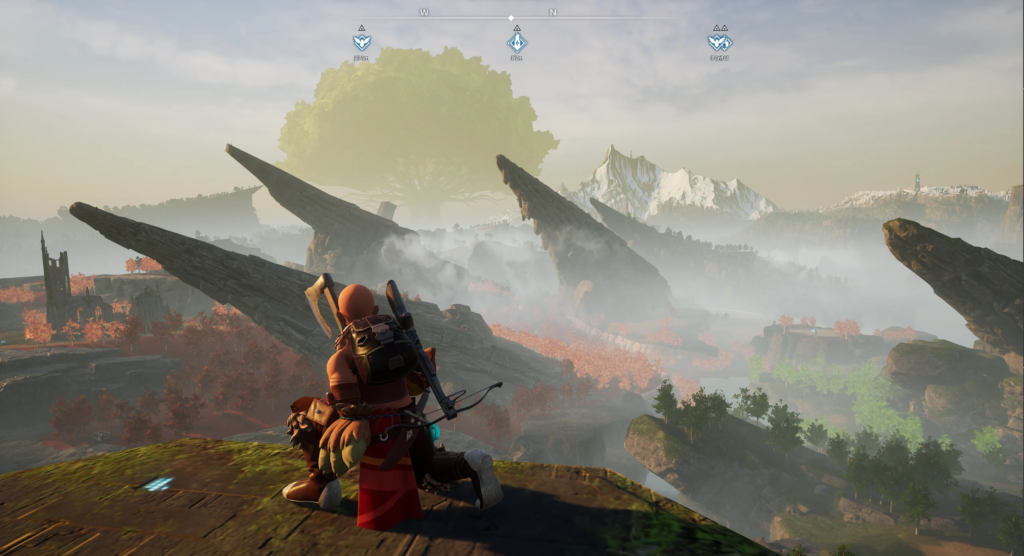
Technical
I personally didn’t encounter any major bugs or crashes, but there are issues with the Pal AI. The good news is fixing the API is top priority for the developers. I wouldn’t be surprised if a big patch directly addressing AI comes out within a week or two from this post as the Devs have made it very clear in their roadmap it’s a key improvement they plan on addressing ASAP. Leaving the game and re-entering the world often fixes AI glitches. There is also an armor equip glitch that allows players to get the benefits of multiple sets of armor and multiple shields.
Palworld supports Mods, but since the game is so new, most of the mods that are available are pretty basic. Current mods include features that add Pause, allow for camera adjustment, provide additional custom settings and always fast travel. There’s mods that enhance the graphics, instantly craft, remove stamina requirements from flying, provide a minimap and even increase the max character level. Want clean screenshots? You can use the mod that allows toggling the HUD on and off.
The Graphics look great and are perfect for the large-scale and distant viewing style of the game. I play with all options maxed out, and it looks good. There are also mods available to enhance the visuals even further.
The Music is relaxing and fun. The Sound FX are great. When you enter the world, you immediately know you’re in Palworld by the sounds of the area around you, your Pals, the UI, building, and engaging in combat. The environmental sounds are very pleasant, and depending on day or night, you’ll hear birds or crickets. There’s also different sounds based on your location in the world. All in all, it’s a very soothing game to listen to as you play.
The User Interface is solid and well-designed. The controls are very easy and intuitive on the PC, allowing for quick switching between party pals, spheres and equipment.
End Game
At the current moment, when you reach Level 50, end-game is about defeating all the bosses, breeding the ultimate Pals and enhancing your bases. The developers say additional content is coming soon, such as new islands, Pals, Bosses, end-game Boss Raids and Technologies. The good news is it takes quite some time on normal settings to get to end-game and the adventure is always a blast. And doing a fresh playthrough even after learning the game and world is still a ton of fun, especially for those who want to tweak the settings to make the game easier or harder.

Ultimately, it takes a lot of time, effort and energy to get to a very comfortable place at Level 50, and just reaching Level 50 doesn’t mean the player has defeated all bosses and secured the best gear in the game.
Conclusion
Palworld really is a masterpiece. It’s a fantastic, fun, immersive and enjoyable game that can be played at any most any pace while appealing to the both casual and hardcore gamers. Players can feel the love that went into designing this game with each Pal, the sounds they make, their animations and the overall look and feel of the world.
And the game is only in early access with a lot of additional content, fixes and enhancements coming very soon. As such, it will only get better.
The success of Palworld is greatly deserved. Congratulations to the developers, and I’m sure it will pass the 10,000,000 sales mark very soon.
Resources
- Palworld Interactive Map
- Palpedia site, all pals, breeding, maps and skills
- A more detailed Interactive Map on mapgenie
- Similar to Palpedia, Palworldtrainer
- All fruit tree spawn locations
- 40+ Tips for Palworld (Video)
- Excellent Palworld breeding guide video
